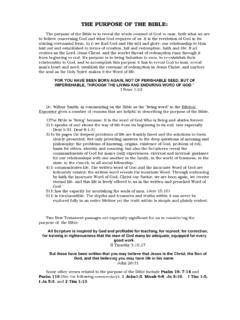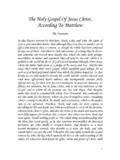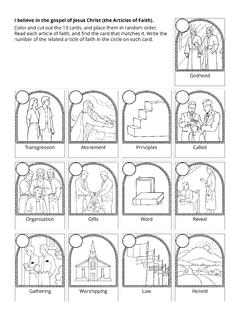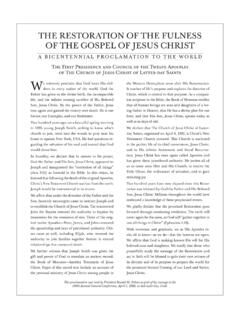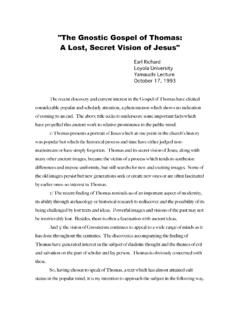Transcription of Jesus’ Leadership Principles and Method of Training His ...
1 jesus Leadership Principles and Method of Training His Disciples " If you had unlimited power, unlimited resources, unlimited time, how would you transform the world. God has a master plan for reaching and transforming a lost world. jesus came with the purpose of reclaiming the world with the gospel . His plan is simple and profound -take twelve ordinary men, give them three years of Training through association with Him, observing and obeying and send them out equipped with the Word, prayer and the Holy Spirit to reproduce disciples, That is the Lord's program, and it is reaching the world. jesus could have made a play for the masses and sought to usher in the kingdom by popular acclaim. The early days of His ministry sought great multitudes drawn to Him. (Mark 1:28,33,45,4:1) Yet He discouraged mass movements, down-played Himself publicly, revealing Himself to His disciples and these who believed instead of the religious leaders, political powers and the masses of the curious.
2 Those who had messianic expectations were disappointed- He made no effort to raise up a following, seize power, overthrow Rome. In fact He made demands in His preaching that turned away many and alienated the establishment. His plan tested on the few men He had chosen. The Lord knew that quality of discipleship and not quantity of disciples was more important. Before the masses could be reached and taught and ministered to there must be Leadership to minister. One man cannot carry the load of the whole world- first a foundation must be laid. jesus concentrated on His disciples for good reasons. Disciples - not converts - was His goal. What was jesus ' master plan to reach the world? His Mission was to reveal Himself as God's son come to redeem God's people to offer Himself up as an atoning sacrifice to reach all of God's people with this gospel His Task was further complicated self-imposed human limitations (Phil 2:6-8) a ministry of only years limited to 30 AD technology and communications His To establish the church, the body of Christ.
3 To reach all of God's elect in every nation. His Method was First to select, disciple and train 12 ordinary men who will be able to evangelize, disciple and train others in the same task. Then to turn them loose equipped with the Word and the Holy Spirit to disciple the nations. We can see a pattern in the ministry of disciple Training that jesus carried on. He did not try to reach all the masses with the gospel . Even if He had wanted to, the task would be too big. Rather He concentrated on a few selected ordinary men, who were "with Him" and to whom He gave both verbal instruction and a constant example - preparing them though their time with Him to do the same. A similar Method of discipleship was practiced by the early churches in Acts. In the long term, devotion to preparing disciples who can reproduce themselves has the potential for greater growth than an emphasis on reaching the masses with large numbers of converts.
4 Preaching to 100,000 people a day with perhaps 4% response would yield 23, converts in 16 years. Taking one convert for 6 months and building a disciple who can reproduce, then each another, then the four another, etc in 16 years would reach 4,000,000,000 people. Multiplication begins smal1, but ultimately yields greater results. And these are disciples, Christians growing and maturing, not babes in the faith demanding constant nurturing. jesus left His disciples at the end of three years to carry on His ministry without Him. The Master Plan of Evangelism, by Robert Coleman is a tremendous study of jesus ' Method of building disciples. The Leadership Training Principles that He used were simple, logical and full of wisdom. They are the Principles that He passed on to the Church. The following eight Principles are a summary of Coleman s book. It is highly recommended. only 126 pages, still available as inexpensive paperback after 30 years.
5 I. Selection: He chose a few faithful, available, teachable (FAT) disciples. (Luke 6:13-17, Mk 3:13-19). They weren't scholars, men with special talents, just ordinary men who he could shape and mould into leaders. He did not spread Himself too thin. 2. Association: He devoted His time to them, even in the midst of ministry to the masses. They were with him in all sorts of situations -called to simply "be with Him" and "follow Him". 3. Consecration: He called them to obedience- to turn away from sin and sacrifice their own personal interests- to turn to Him and His teaching. He called them to commit them selves not to a doctrine or program, but to His person. 4. Impartation -He gave Himself to them and for them. The foundation of their relationship to Him was His love and self denial. He lived discipleship before them on a daily basis and there was no limit to His love for them. His commitment to them, and giving of Himself for them was the motivation of their giving themselves totally for Him.
6 5 Demonstration: He taught them by showing them. All the disciples had to teach them was a teacher who practiced with them what He expected them to learn .So they learned to pray by hearing Him pray, learned how to use the Word by observing His handling of it, learned how to minister by watching Him ministering. They became evangelists by His demonstrations of evangelism. Discipleship is easier caught than taught. 6 Delegation: He put them to work. (Mk 6:7, Mt 10:5, Luke 9:1,2) They assisted Him as He ministered, gradually He sent them out two by two. The instructions He gave them are most interesting, revealing how even this was a part of their preparation as His disciples. 7. Supervision: He kept check on them and used their experiences to instruct them further. (Mk 6:30) This was on the job Training at its best. They were given adequate room to work and learn, yet never without His concern and guidance as it was needed.
7 8 Reproduction: it is clear that He intended them to become disciplers. The church is like the mustard seed, it starts out small- yet we expect it to grown bigger than the crops around it. Jn 15:1-17 the branch abiding in the vine must bear fruit. The wisdom and strength of His methodology stands out. He chose those who were teachable, and devoted him self to them. He established a relationship based on commitment to Him on their parts, and His commitment to them on His. He showed them how, then sent them out to learn by doing, using their successes and failures to make them into men able to do what He was doing with them - reproducing. The New Testament reveals that these Principles became the pattern for the early church. We find Paul using them in His missionary work- residing in a city just long enough to reproduce Leadership for a new church, then returning periodically. He urges Timothy to make disciplers (2 Tim 2:2).
8 There is Apollos, mighty in the church, discipled by Aquila and Priscilla, disciples of the disciple of Barnabas: Paul. There is Mark whom Paul gave up on, whom Peter succeeded with - the author of the first of the Gospels to be written. Titus, Luke, etc - the New Testament abounds with the evidence that jesus ' program of discipleship has been passed on to the church. Of course, jesus was a perfect Leader. We, however, are all imperfect leaders, as were many leaders in the Bible such as Joseph (who organized Egypt for famine); Moses (who lead 2 million grumbling people for 40 years in the wilderness); Nehemiah (who rebuilt Jerusalem s wall in the face of opposition) and Paul (who organized numerous churches and trained leaders for them.) You are strongly encouraged to study their characters and lives, and the ways God trained them as leaders, both through their mistakes and their successes. And especially how they used jesus Leadership Principles successfully in their Leadership .
9 The Seven Step Disciple Training Program The next part of this study is an examination of the seven stages in the process jesus used in preparing his disciples. The main resource is the gospel accounts, however, a book by Carl Wilson: With Christ In the School of Disciple Building furnishes an outline of the seven steps or stages that Christ used with His disciples in preparation for their world wide ministry. It is Wilson s thesis that careful study of the Gospels with a harmony reveals a definite pattern to jesus ' teaching of, first, the twelve, and then, a second group, the Seventy. Perhaps the One Hundred and Twenty at the time of the resurrection was group number three. The Gospels thus have a two fold purpose: present jesus and the gospel ! prepare the church to continue His ministry! The second is not as obvious as the first, but with careful study of jesus ' methodology, a pattern becomes clear.
10 This summary of His steps in Training disciples is based on the following studies: With Christ in the School of Disciple Building, by Carl Wilson (Zondervan, 1979) - a detailed exposition of these stages. The Master Plan of Evangelism (Fleming H. Revell Co., 1979), by Robert E. Coleman ; The Training of the Twelve (Kregel Publications, 1971) by A. B. Bruce - very valuable studies of Christ's methods of Training his disciples. The Gospels are more than sources for our teaching about jesus , they are also "manuals" for continuing His mission! The Gospels were written not only to teach us about Christ and His ministry, but also to serve as a pattern for us, guiding the church in its mission to reach the world. That is why they are much more than a biography of jesus . While each has its own particular themes and emphases, together they give us a rather complete picture of the Master's plan that he has passed on to His church.

